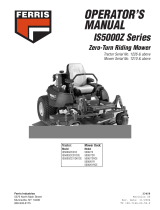
7
Operator Safety
Service and Maintenance
To avoid personal injury or property damage, use extreme
care in handling gasoline. Gasoline is extremely flammable
and the vapors are explosive.
Safe Handling of Gasoline
1. Extinguish all cigarettes, cigars, pipes, and other
sources of ignition.
2. Use only approved gasoline containers.
3. Never remove the gas cap or add fuel with the
engine running. Allow the engine to cool before
refueling.
4. Never fuel the machine indoors.
5. Never store the machine or fuel container where
there is an open flame, spark, or pilot light such as
near a water heater or other appliance.
6. Never fill containers inside a vehicle or on a truck
bed with a plastic bed liner. Always place containers
on the ground away from your vehicle before filling.
7. Remove gas-powered equipment from the truck
or trailer and refuel it on the ground. If this is not
possible, then refuel such equipment on a trailer with
a portable container, rather than from a gasoline
dispenser nozzle.
8. Keep nozzle in contact with the rim of the fuel tank
or container opening at all times until fueling is
complete. Do not use a nozzle lock-open device.
9. If fuel is spilled on clothing, change clothing
immediately.
10. Never over-fill the fuel tank. Replace gas cap and
tighten securely.
11. Use extra care in handling gasoline and other fuels.
They are flammable and vapors are explosive.
12. If fuel is spilled, do not attempt to start the engine
but move the machine away from the area of spillage
and avoid creating any source of ignition until fuel
vapors have dissipated.
13. Replace all fuel tank caps and fuel container caps
securely.
Maintenance and Storage
1. Always observe safe refueling and fuel handling
practices when refueling the unit after transportation
or storage.
2. Always follow the engine manual instructions for
storage preparations before storing the unit for both
short and long term periods.
3. Always follow the engine manual instructions for
proper start-up procedures when returning the unit to
service.
4. Never store the machine or fuel container inside
where there is an open flame, such as in a water
heater. Allow unit to cool before storing.
5. Shut off fuel while storing or transporting. Do not
store fuel near flames or drain indoors.
6. Keep all hardware, especially blade attachment
bolts, tight and keep all parts in good working
condition. Replace all worn or damaged decals.
7. Never tamper with safety devices. Check their
proper operation regularly.
8. Disengage drives, lower implement, set parking
brake, stop engine and remove key or disconnect
spark plug wire. Wait for all movement to stop
before adjusting, cleaning or repairing.
9. Clean grass and debris from cutting units, drives,
mufflers, and engine to prevent fires. Clean up oil or
fuel spillage.
10. Let engine cool before storing and do not store near
flame.
11. Stop and inspect the equipment if you strike an
object. Repair, if necessary, before restarting.
12. Park machine on level ground. Never allow
untrained personnel to service machine.
13. Use jack stands to support components when
required.
14. Carefully release pressure from components with
stored energy.
15. Disconnect battery or remove spark plug wire
before making any repairs. Disconnect the negative
terminal first and the positive last. Reconnect
positive first and negative last.
16. Use care when checking blades. Wrap the blade(s)
or wear gloves, and use caution when servicing
them. Only replace blades. Never straighten or
weld them.
17. Keep hands and feet away from moving parts. If
possible, do not make adjustments with the engine
running.
18. Charge batteries in an open well ventilated area,
away from spark and flames. Unplug charger before
connecting or disconnecting from battery. Wear
protective clothes and use insulated tools.
19. Grass catcher components are subject to wear,
damage, and deterioration, which could expose
moving parts or allow objects to be thrown.
Frequently check components and replace
with manufacturer’s recommended parts, when
necessary.
20. Check brake operation frequently. Adjust and
service as required.
21. Use only factory authorized replacement parts when
making repairs.
22. Always comply with factory specifications on all
settings and adjustments.
23. Only authorized service locations should be utilized
for major service and repair requirements.
24. Never attempt to make major repairs on this unit
unless you have been properly trained. Improper
service procedures can result in hazardous
operation, equipment damage and voiding of
manufacturer’s warranty.
25. Units with hydraulic pumps, hoses, or motors:
WARNING: Hydraulic fluid escaping under pressure
may have sufficient force to penetrate skin and
cause serious injury. If foreign fluid is injected into
the skin it must be surgically removed within a few
hours by a doctor familiar with this form of injury or
gangrene may result. Keep body and hands away
from pin holes or nozzles that eject hydraulic fluid
under high pressure. Use paper or cardboard,
and not hands, to search for leaks. Make sure
all hydraulic fluid connections are tight and all
hydraulic hoses and lines are in good condition
before applying pressure to the system. If leaks
occur, have the unit serviced immediately by your
authorized dealer.
26. WARNING: Stored energy device. Improper
release of springs can result in serious personal
injury. Springs should be removed by an authorized
technician.
27. Models equipped with an engine radiator:
WARNING: Stored energy device. To prevent
serious bodily injury from hot coolant or steam blow-
out, never attempt to remove the radiator cap while
the engine is running. Stop the engine and wait
until it is cool. Even then, use extreme care when
removing the cap.





















